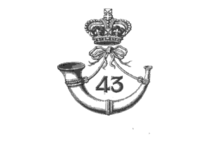43rd (Monmouthshire) Regiment of Foot (Light Infantry)
| 43rd (Monmouthshire) Regiment of Foot | |
|---|---|

Badge of the 43rd (Monmouthshire) Regiment of Foot Badge
|
|
| Active | 1741–1881 |
| Country |
|
| Branch |
|
| Type | Infantry |
| Size | One battalion (two battalions 1804–1817) |
| Garrison/HQ | Copthorne Barracks, Shrewsbury |
| Engagements |
Seven Years War American War of Independence Peninsular War Battle of New Orleans Indian Mutiny New Zealand Wars |
The 43rd (Monmouthshire) Regiment of Foot was an infantry regiment of the British Army, raised in 1741. Under the Childers Reforms it amalgamated with the 52nd (Oxfordshire) Regiment of Foot (Light Infantry) to form the 1st and 2nd battalions of the Oxfordshire Light Infantry in 1881. The regiment went on to become the Oxfordshire and Buckinghamshire Light Infantry in 1908.
The regiment was raised at Winchester by Colonel Thomas Fowke as Thomas Fowke's Regiment of Foot in 1741. The regiment's first deployment was on garrison duties at Minorca in 1742. The regiment was numbered 54th Regiment of Foot from 1747 until 1751 when it became the 43rd Regiment of Foot.
In May 1757 the 43rd sailed for North America, arriving at Halifax, Nova Scotia, the following month to defend the British North American Colonies during the French and Indian War (the North American Theatre of the Seven Years' War) against France. A detachment of the 43rd was defeated in a skirmish with Mi'kmaq and Acadian resistance fighters at Bloody Creek near Fort Anne on 8 December 1757. The regiment had spent almost two years on garrison duties when, in 1759, as part of General Wolfe's force, it took part in the capture of Quebec gaining its first battle honour. The next campaign was in the West Indies where the 43rd took part in the capture of Martiniquein January 1762 and of Saint Lucia later in the month from the French and the capture of Havana In August 1762 from the Spanish.
...
Wikipedia
